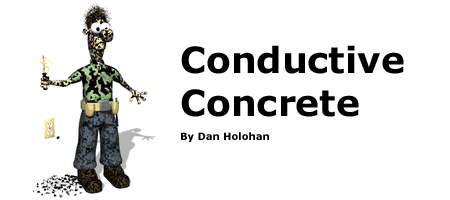The Need
Concrete has been used for many years as a composite material that has excellent mechanical properties and durability for construction. However, concrete is a poor electrical conductor, especially under dry conditions. Concrete that is excellent in both mechanical and electrical conductivity properties may have important applications in the electrical, electronic, military and construction industry (e.g. for de-icing road from snow). Traditional methods can warm roads, but installation cost is high and the procedure is complicated.
The Technology
A research team in Material Laboratory of Institute for Research in Construction, National Research Council Canada, led by Dr. James J. Beaudoin, has developed a new conductive concrete with both superior electrical conductivity and mechanical properties.
The principle behind it is the use of cement to bind together electrically conductive materials such as carbon fiber, graphite and ‘coke breeze’ – a cheap by-product of steel production – to make a continuous network of conducting pathway. The design formulation is based on the ‘electrical percolation’ principle by which the composite conductivity increases dramatically by several orders of magnitude when the content of the conductive phase reaches a critical ‘threshold’ value. Further increases in the conductive phase content boost composite conductivity only slightly. The design specifies an amount just over the threshold content, assuring high conductivity and mechanical strength as well as good mixing conditions.
Conductive concrete particles and fibers are added to conventional aggregate and cement paste compositions to achieve the conductive concrete, which can be fabricated by two methods. The first one is by conventional mixing, which has relatively higher resistivity and high compressive strength. The second one is by slurry infiltration. This method can increase compressive and flexural strengths, and lower resistivity can be obtained.
The conductive concrete can be used as a structural material and bonds well with normal concrete. The conventional mixing type is lightweight, with only 70 per cent of normal concrete weight. Thermal stability is comparable to normal concrete, production employs conventional mixing and casting equipment, and application of the conductive concrete is similar to that of conventional concrete.
The conductive concrete could be used along with specially configured electrodes and an electric power supply to provide de-icing on roads, sidewalks, bridges and runways. Placed as an overlay, conductive concrete with very low resistivity can be used as a secondary anode in existing cathodic protection systems, providing uniform current distribution over its large surface area and reduced anodic current density.
At the same time, it provides excellent mechanical stability due to its load-bearing capacity and its bond strength as an overlay. And because conductive concrete attenuates electromagnetic and radio waves, it can be used to shield computer equipment from eavesdropping efforts and protect electrical installations and electronic equipment from interference.
The Benefits
- Conductive concrete has excellent mechanical and electrical conductivity properties.
- It is much lighter in weight than conventional concrete.
- It can be produced easily, without special equipment.
- It will reduce the need of salts and save millions in dollars in snow removal costs.
- It warms by power taken off line, it uses an AC current and a 120 Volt plug.
- It is also safe for a person crossing a charged concrete pathway.
- It can also be used for protecting structures against static electricity and lightning, and preventing steel structures and reinforcing layer of steel in concrete structures from corroding.
- It absorbs over 90% of the electromagnetic energy and it is cheaper and more convenient than the existing ways of blocking out electromagnetic energy.
Status
Popular Science magazine has honored conductive concrete a top prize for innovation. Conductive concrete has been granted a U.S. patent and is available to Canadian and international partners for application development under license from IRC.
One of the recent implementations of this technology was the use of conductive concrete overlay for bridge deck de-icing conducted by Department of Civil Engineering, University of Nebraska-Lincoln, and sponsored by Nebraska Department of Roads.
Points of Contact
- James J. Beaudoin, Principal Research Officer, Building Envelope and Structure, Institute for Research in Construction, National Research Council Canada, Bldg M-20, Montreal Road, Ottawa, Ontario K1A 0R6, Phone: 613-993-6749, Fax: 613-954-5984, Email: [email protected]
- Chris Tuan, Department of Civil Engineering, 125C Engineering Building, University of Nebraska – Lincoln, Omaha, NE 68182-0178, Tel: (402) 554-3867, Fax: (402) 554-3288, Email: [email protected]
References
- “Electrified Concrete: Melting Snow and Ice with the Flick of a Switch”, Western Area Power Administration, http://www.es.wapa.gov/pubs/electrotech/at_concrete.htm
- “Conductive Concrete Wins Popular Science Prize”, Construction Innovation, Vol. 2, No. 3, NRC-IRC, Winter 1997, http://wolf.cisti.nrc.ca/irc/newsletter/v2no3/popular_e.html
- Ping Xie, Ping Gu and J.J. Beaudoin, “Electrical Percolation Phenomena in Cement composites Containing Conductive Fibres”, Journal of Materials Science 31, 4093-4097 (1996).
- “Conductive Concrete Seeks Licensing Agreements”, Construction Innovation, Vol. 1, No. 1, NRC-IRC, July 1995, http://www.nrc.ca/irc/newsletter/v1no1/v1no1p8.html
- “Concrete Conductor”, Construction Materials, Chemistry & Industry News, 17 March 1997, http://biotech.mond.org/9706/970611.html
- Tuan, C., “Conductive Concrete Overlay for Bridge Deck Deicing,” http://www.engext.unl.edu/CE/Profiles/tuan/deck.html
Disclaimer Statement
Neither the Construction Industry Institute nor Purdue University in any way endorses this technology or represents that the information presented can be relied upon without further investigation.
Dan Holohan



Home › Forums › Conductive Concrete